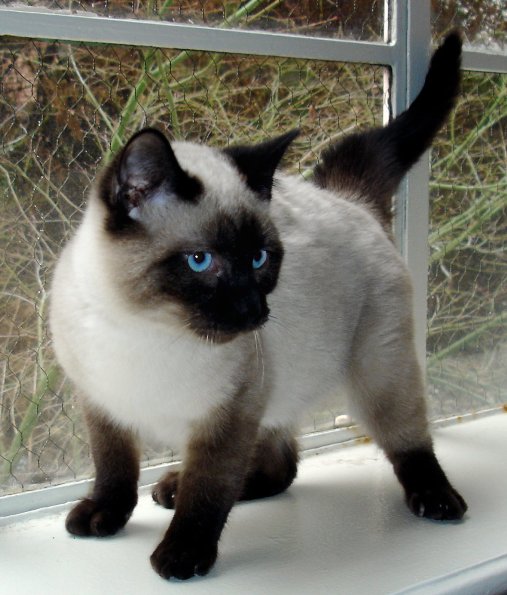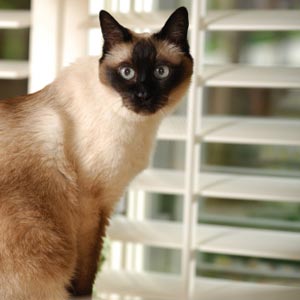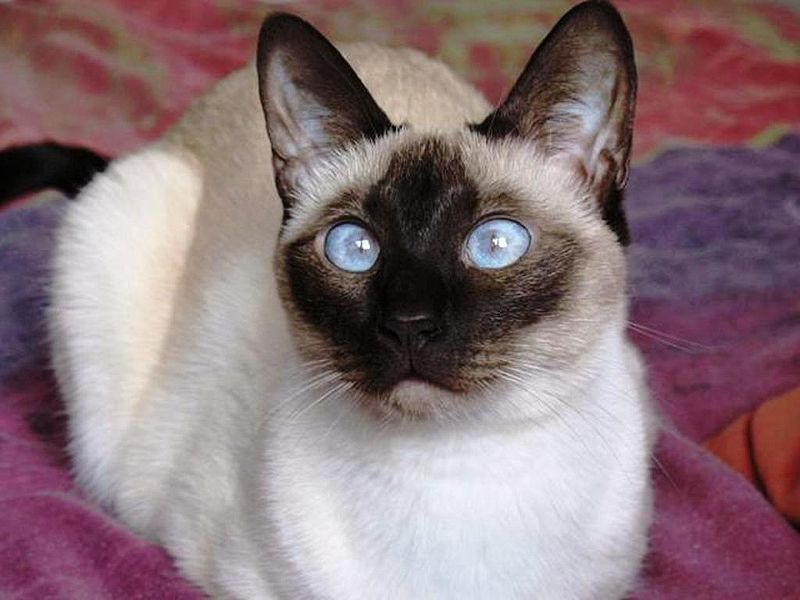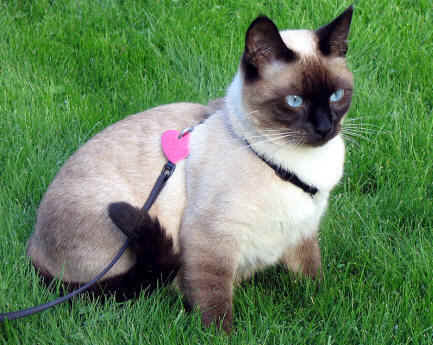



|
Siamese Description
The Extreme Siamese is the darling of the show-ring and sports a smooth, wedge-shaped head with large ears. The eyes are almond shaped and set one eye's width apart. They are slanted and a deep, radiant blue that displays intelligence and emotion. The neck is long and thin, a Hepburn neck, and the line continues through the tubular body and tail. The body should appear graceful and delicate with long, thin legs and small oval feet. Males average 11-15 pounds with females weight 8 -12.
The coat of the Siamese should be bright and even with no clouding, and colored either fawn, dun or ash. The feet, legs, and tail should be dark; the back is allowed to be dark and darkening is permitted for older cats as the coat darkens with age, however clouding is never permissible. There are four colors accepted by the CFA: Seal, Blue, Chocolate and Lilac.
The Traditional Siamese has a wider wedge-shaped head and its subclass, the Classic, sports a rounded head. Color standards hold through for both, though the eye color on the Traditional and Classic tends towards a cornflower or sapphire blue.
It is interesting to note that the darker coloring on the limbs and points is caused by cooler temperatures. Siamese are born a solid color as they are warmed by their mothers. As they grow, the coloring develops. The cooler the climate the darker the points will be.
Siamese Temperament
The Siamese is a very loving and longing companion. They crave attention from their humans and need companionship or they will pine. It is best, if you have a busy lifestyle, to have a pair of Siamese so they can keep one another company. Known for it's vocals, the Siamese will carry on a conversation with you, responding to your words with both voice and body. Being a vocal animal, if they have a point to make you can be sure you will hear about it; don't be surprised if you're on the phone and someone asks if there is a baby crying while your Siamese demands your attention.
They are great with children, seeming to understand that the hand of a toddler is less coordinated and falls heavier than that of an adult. A Siamese will follow you from room to room, and demand your lap when you are seated. They love to play fetch, returning the toy to your lap rather than your feet. They will not tolerate being isolated or ignored.
Siamese are very intelligent, though this does not mean easy to train. While one Siamese may instantly obey a command of "No!", another may simply wait till your back is turned before giving in to their curiosity. They also love to be up high and it is best to remove any breakables from the tops of shelves.
Siamese Care
The coat of the Siamese is very short, making the cat very easy to care for. Brushing, while always appreciated, is not necessary. The cat is capable of bathing itself and remaining clean. Siamese should not be allowed outdoors. Though the breed is predominantly hardy, there is the possibility of a disease called Endocardio Fibroelastosis. This is a serious heart condition and owners should be careful to question breeders about the health history of their kitten and have their kitten examined by an animal health professional.
Siamese History
The history of the Siamese is clouded with controversy. Though everyone can agree that the breed hails from Thailand, historically known as Siam, there are a number of different stories concerning when the first Siamese appeared in the western hemisphere. One story suggests that the first cat was introduced in the late 1800's; the pet of an Ambassador to whom it had been given as a gift. This is contradicted, however, by the mention of a Siamese 13 years earlier at the first cat show in London's Crystal Palace. They were unkindly described as "an unnatural, nightmare kind of cat.".
Once introduced to the world of professional cat shows, the breed grew in popularity. By the end of World War II, demand for the breed had skyrocketed and breeders were attempting to mass produce the animal in attempts to meet demand. This led to the current controversy between breeders. There are two types of Siamese breeders, Extreme and Traditional or Appleface. Both breeders claim that their style Siamese is the historically accurate version. The Extreme Siamese has the backing of the CFA and is best recognized for it's long, thin lines and severely wedge-shaped head. The Traditional, or Appleface, is a fuller and rounder cat with a faithful following of breeders and owners.
Despite this, the Siamese remains the best loved of all cats in one way or another. A great number of breeds including the Himalayan Persian, owe their genetics to the Siamese. The breed has been involved in the creation and sustainment of some of the most beloved breeds; Balinese, Tonkinese, Javanese all owe the Siamese for its contributions. It is a staple of the pedigreed cat world, providing not only great beauty but genetic contributions that have created and continue to sustain a good number of the best loved breeds. It is the Siamese that claims the honor of being the breed of that most brilliant of cats from the "Cat Who" book series, Koko.
|